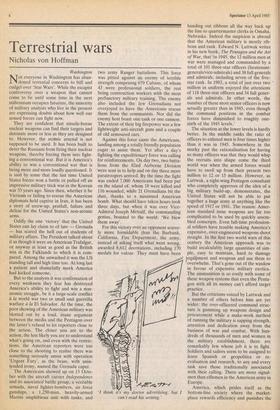Terrestrial wars
Nicholas von Hoffman
Washington 'Mot everyone in Washington has aban- doned terrestial concerns to biff and
cudgel over 'Star Wars'. While the escapist controversy over a weapon that cannot come to be until some time in the next millennium occupies futurists', the minority of military analysts who live in the present are expressing doubts about how well our armed forces can fight now.
They are confident that missile-borne nuclear weapons can find their targets and detonate more or less as they are designed to. However, the atomic arsenal is not supposed to be used. It has been built to deter the Russians from firing their nuclear weapons, thereby forcing them into fight- ing a conventional war. But it is America's ability to win, a conventional war that is being more and more loudly questioned. It is said by some that the last time United States forces won a battle or pulled off an impressive military trick was in the Korean war 35 years ago. Since then, whether it be Vietnam or failing to rescue the American diplomats held captive in Iran, it has been a story of screw-up, pratfall, failure and defeat for the United States's non-atomic arms.
Oddly the one 'victory' that the United States can lay claim to of late — Grenada — has scared the hell out of students of military affairs. The President talked about it as though it were an American Trafalgar, or anyway at least as good as the British win in the Falklands to which it is com- pared. Among the unwashed it was the US standing tall and high time too. At long last a patient and shamefully meek America had kicked someone.
But to the analysts it was confirmation of every weakness they fear has destroyed America's ability to fight and win a non- atomic struggle, be it a large-scale conflict a la world war two or small unit guerrilla warfare a la El Salvador. At the time, the poor showing of the American military was blotted out by a loud, inane argument between the media and the Pentagon over the latter's refusal to let reporters close to the action. The closer you are to the action, the less likely you are to understand what's going on, and even with the restric- tions, the American reporters were too close to the shooting to realise there was something seriously amiss with operation 'Urgent Fury', as the brass, with unin- tended irony, named the Grenada caper.
The Americans showed up on 15 Octo- ber with the aircraft carrier Independence and its associated battle group, a veritable armada, naval fighter-bombers, air force gunships, a 1,250-man, heavily-armed Marine amphibious unit with tanks, and
two army Ranger battalions. This force was pitted against an enemy of terrible strength comprising 679 Cubans, of whom 43 were professional soldiers, the rest being construction workers with the most perfunctory military training. The enemy also included the few Grenadians not overjoyed to have the Americans rescue them from the communists. Nor did the enemy host boast one tank or one cannon. The extent of their big firepower was a few lightweight anti-aircraft guns and a couple of old armoured cars.
Against this force came the Americans, landing among a totally friendly population eager to assist them. Yet after a day's fighting the expeditionary force was calling for reinforcements. On day two, two batta- lions from the 82nd Airborne Division were sent in to help and on day three more paratroopers arrived. By the time the fight was ended 7,000 Americans had been put on the island of, whom 18 were killed and 116 wounded, while 21 Grenadians bit the dust, thanks to a misaimed American bomb. What should have taken hours took three days, but when it was over Vice- Admiral Joseph Metcalf, the commanding genius, boasted to the world: 'We blew them away'.
For this victory over an opponent scarce- ly more formidable than the Burbank, California, Fire Department, the army, instead of asking itself what went wrong, awarded 8,612 decorations, including 170 medals for valour. They must have been 'I think is my doctor advertising, but can't read his writing.' handing out ribbons all the way back up the line to quartermaster clerks in Omaha, Nebraska. Indeed the suspicion is abroad that the American military is mostly rib- bons and rank. Edward N. Luttwak writes in his new book, The Pentagon and the Art of War, that 'in 1945, the 12 million men at war were managed and commanded by a total of 101 three-star officers (lieutenant- generals/vice-admirals) and 38 full generals and admirals, including seven of the five- star rank. In 1983, a total of just over two ' million in uniform enjoyed the attentions of 118 three-star officers and 34 full gener- als and admirals. In other words, the number of these most senior officers is now actually greater than in 1945, even though the command positions in the combat forces have diminished to roughly one- sixth of the 1945 levels.'
The situation at the lower levels is hardly better. In the middle ranks the ratio of officers to enlisted men is four times higher than it was in 1945. Somewhere in the murky past the rationalisation for having so many officers was that they would whip the recruits into shape come the third world war when the armed forces would have to swell up from their present two million to 12 or 15 million. However, as Luttwak, a right-wing Pentagon consultant who completely approves of the idea of a big military build-up, demonstrates, the United States will not be able to put together a huge army at anything like the speed of 1917 or 1941. The reason: Amer- ican standard issue weapons are far too complicated to be used by quickly assem- bled conscripts. Even full-time profession- al soldiers have trouble making America's expensive, over-engineered weapons shoot straight. In the first two world wars of this century the American approach was to build incalculably large quantities of sim- ple, easy to maintain, hard to damage equipment and weapons and use them to overwhelm. That's gone out of the window in favour of expensive military exotica. The ammunition is so costly with some of these weapon systems that even the Penta- gon with all its money can't afford target practice.
But the criticisms voiced by Luttwak and a number of others before him are yet wider: the over-officered command struc- ture is gumming up weapons design and procurement while a make-work method of running the military is sapping strength, attention and dedication away from the business of war and combat. With hun- dreds of thousands of men and women in the military establishment, there are remarkably few whose job it is to fight.
Soldiers and sailors seem to be assigned to learn Spanish or geopolitics or re- evaluation and research, to any and every
task save those traditionally associated with their calling. There are more signal- men than riflemen in the American army in Europe.
America, which prides itself as the / bottom-line society where the market- place rewards efficiency and punishes the
lack of it, has a military establishment indifferent to failure. Since its defeat in Vietnam the military has blamed the press, the protesters, the politicians, any and everyone for the loss, but the one thing it has not done is convene a commission or a court of inquiry to explain how an Amer- ican force of more than half a million and undreamt-of firepower could be whipped by an army half its size. Instead, the critics Point out, the losing general was prom- oted, but then so too was the army officer in charge of the failed attempt to rescue the People in the embassy in Teheran.
Many of the causes of failure have been repeatedly pointed out — too many layers Of command, inter-service rivalries, over- staffing from the battalion level upwards, inability to choose the right military tool for the job because of an over-reliance on complexity and elaborate weaponry. There are officers aplenty who know what's Wrong but, taken as a whole, the Pentagon IS unable to learn from failure and correct its mistakes.
One of its most costly, most critics agree, has been the starvation of the army to build UP the navy and the marines. You do not have to be a graduate of the National War College to figure out that the only major Potential enemy the United States has in the world is a land power. Why, then, has the United States spent so much on its navy? The critics, few of whom are ban- the-bombers, have no quarrel with the
Trident submarine programme, which is part of the nuclear deterrent. It is the hundreds of billions going into the surface ships that they object to. If this were 45 years ago and the enemy was the island empire of Japan there would be something for this gigantic navy to do. As it is, America is the only nation in the world to have not one but two battleships, although their only mission is to bob around and be Ronald Reagan's bathtub toys.
It's the aircraft carriers, however, that have students of military affairs aghast. To protect behemoths like the 98,000-ton Carl Vinson, named after a dead and already forgotten politician, a carrier must be escorted by destroyers, frigates, cruisers and attack submarines. In addition the aircraft carrier has over 40 aeroplanes on board whose duty is to protect the mother ship, leaving only about 35 others for attack. There are now 14 of these carriers, each with its own not so little protective navy, floating about the world's oceans looking impressive but not good for much beside overawing natives in the dugout canoes. But who knows what war the Pentagon thinks it may be called on to fight? Look at the row with New Zealand, a nation whose naval co-operation the United States will need in the event of the king penguins of Antarctica starting to march northward in search of warmer Lebensraum.
The inexplicable pro-navy bias, already present in American military planning be- fore the Reagan administration, has grown more pronounced in the last five years. Under the President's 're-arm America programme' the size and fighting capacity of the air force and the army have hardly grown at all: it's the navy that's gotten the gravy.
When and whether these criticisms will ever get full debate is problematical. They must compete for the nation's attention with the never-ending train of national defence procurement scandals. . . paying $6,000 for a coffee pot or $748 for a pair of two-buck pliers. Perhaps the largest de- fence bribery and corruption scandal in many years is threatening to break out through the revelations of Pan agiotis Takis Veliotis, a Greek national who was the manager of the General Dynamics Cor- poration's electric boat division (which builds the atomic submarines). Veliotis, though now a fugitive in Greece from an American subpoena, has been singing to the Justice Department about all kinds of goings-on with the nation's largest defence contractor and some of our highest ranking officers.
In any event, between Mr Luttwak, whose book is being read in Washington, and Mr Veliotis, who says brass corrupts and rusts as well as iron, there should be enough happening on earth to divert atten- tion from military star-gazing and laser warfare in the cosmos.















































 Previous page
Previous page